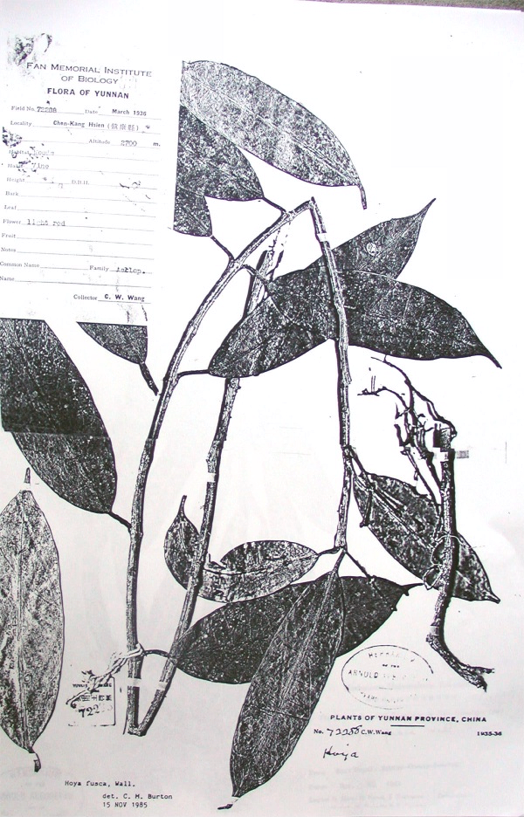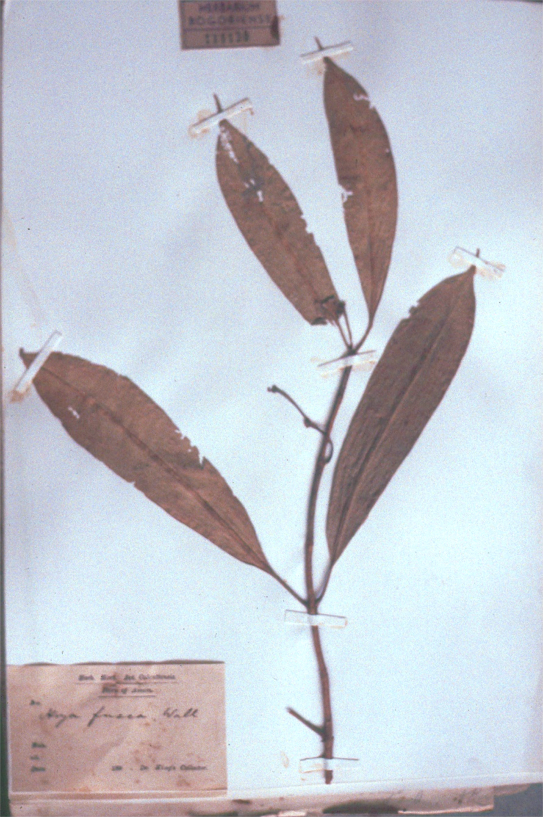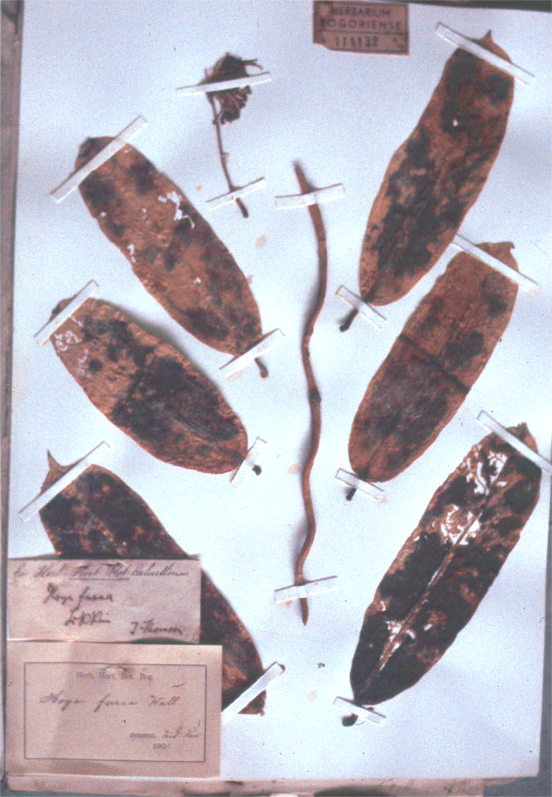
Hoya fusca Wallich
Type description:
In Plantae Asiaticae Rariores 1 (1930) 68. Wallich. Hoya fusca. Tal. 75. Radicans, ramosissima; foliis oblongis, acuminatis; corolla laevissima, coronae foliolis subtus sulco exaratis. Habitat super rupibus arborumque truncis montium valli Napaliae vicinarum; etiam in Napalia inferiore secus ripas fluminis Rapti. Floret Augusto; fructus profert Octobri.
Planta fruticosa, magna, latissime radicans, ramosissima, omnino laevis, omnibus partibus copiose lactescens. Rami longi, cylindrici pennam cygneam, usque ad digitum modicum crassi, plus minusve penduli, epidermide cinerea, pallida obtecti, ad foliorum insertionen parum tumidi, et vestigio annulari ciliarum notati. Folia approximata, opposita, patentissima, valde crassa et coriacea, firma, plana oblonga, acumine angusto, semipollicari terminata, marginibus parallelis convexis, basi obtusa, supra atroviridia, lucida, ad insertionen petioli utrinque corpusculo cinereo, emarcido (loco acervuli soliti ciliarum), subtus pallida, subargentea, costa valde elevata, nervis trans versis, capillaceis, intra marginem arcuatim anastomosantibus; 6—7 pollicaria. Petioli crassi, convexi, supra parum sulcati, semipollicares Flores magni, fusci, nitidi, inodori, valde numerosi, densissime dispositi in umbellam hemisphaericam, lateralem, extra‑axillarem, diame trum 3‑polllcarem emetientem, erectam, pedunculatam, vix ad tertiam inferiorem folii partem elevatam, subinvolucratam. Pedunculus communis crassus, cylindricus, petiolo dimidio longior; partiales teretes, pollicares, subclavati, exteriores ad basin muniti bracteola ob longa, obtusa, ciliata. Calyx quinquefidus, parvus; laciniae ovatae, obtusae, ciliatae, basi extus gibbosae. Corolla rotata, plana, patentis sima, demum reflexa; laciniae lanceolatae, subacuminatae, marginibus subrevolutae, subtus concaviusculae. Columna pentagona, truncatae pallide fusca, 5‑loba; lobi depressi, subtus profunde sulcati, supra concaviusculi, angulo interiore producto in dentem subulatum, longum anthere ovat e, obtusae, membranula cinctae oppositum. Massae Pollinis luteae, tenues, longiusculae, lineari‑clavatae, erecto‑divergentes, basi acuti apici corpusculi minuti, sulcati, fusci insertae. Stigma 5‑angulare, vertice in umbilicum obtusum productum, antheris occultum Folliculus saepius solitarius, cylindricus, laevis, 4‑pollicaris; maturus haud observatus.
Translation: Spreading branched very little, leaves oblong, acuminate; corolla very smooth, leaflets of the corona grooved and furrowed below. Lives above on rocks in the forest and on the trunks in the mountain valleys in the vicinity of Nepal, furthermore below Nepal along the banks of the Raspti river. Florets narrow; fruits prolifically in October.
A fruiting plant, large broadly spreading, very little branched altogether smooth, and all parts with copious milk. Stems long cylindrical, winged, up to 1 inch or less thick, plus or minus pendulous, epidermis grayish, covered with pale whitish. Inserted on the thickened petiole, and traces of the annual marked cilium. Leaves approximately opposite, very outspread, strongly thick and leathery, firm, flat, oblong narrowly acuminate ½ inch terminal, margins parallel convex, base obtuse, above purple veined, shinny on both sides of the petiole insertion a gland withered (at this place a solitary cilia) below flat, somewhat green, midrib very much elevated, various transverse nerves, capillaries near the margins anastomosing, 6 to 7 inches. Flower large, brownish, shinny without smell, very numerous, very dense in hemispherical lateral umbels, beyond the axils, 3inches in diameter, erect, pedunculate, becoming elevated in part 1/3 in the lower part of the leaf. Peduncles commonly thick, cylindrical, petiole somewhat longer, circular, 1 inch, somewhat cut off, exterior at the base with many bracts, oblong obtuse, ciliate. Calyx of 5 parts, small, leaflets ovate, obtuse ciliate, base outside with bumps. Corolla rotate, flat, somewhat shinny, at length reflexed, flaps lanceolate, somewhat acuminate, margins somewhat revolute, below concave. Column pentagonal, truncate pale brown, 5 lobed, lobes depressed, below profoundly grooved, above concave, interior angle produced into a sharp pointed tooth, with long ovate anthers and obtuse enclosing the opposite membrane. Pollinia masses yellow, thin, somewhat long linear a little club shaped, erect divergent, base acute corpuscles minute grooved, brown, inserted. Stigma 5 angled, produced with a obtuse umbilical tip, anthers hidden. Follicle often solitary, cylindric, smooth, 4 inches, did not observe at maturity.
In Contributions to the Botany of India (1834) 37. R. Wight & Wallich. 7. H. fusca (Wall.:) volubilis glabra, foliis coriaceis vix carnosis lineari-oblongis acuminatis (5-8 unicas longis 1-1 ½ latis) transversim venosis, pedunculatis brevibus multifloris, corolla glabra segmentis obtusis, cor. st. foliolis ovatis obtusis angulo interiore attenuato erecto stigma apiculatum superante — Wall. ! pl. As. rar. 2. p. 78. t. 175; Asclep. n. 30. — Nepal; Silhet; Wallich. The flowers are rather small, brownish coloured, and very numerous.— (R. W.).
Editors Notation: The reference above of Wight’s for Wallich’s Pl. As. rar. is incorrect see this 1830 description above.
Translation: twining glabrous, leaves leathery barely fleshy linear-oblong acuminate (5 to 8 inches long 1 to 1 ½ wide) transversely veined, peduncles short umbel-like, corolla glabrous segments obtuse, corona star-like leaflets ovate obtuse with the interior angle erect attenuate stigma apiculate overtopping.
In Synopsis Plantarum (1840) 891. D. N. F. Dietrich 7. H. fusca Wall. volubilis glabra, fol. lineari-oblongis acuminatis; pedunc. Multifloris; cor. Glabra laciniis obtusis. In Nepalia.
Translation: twining glabrous; leaves leathery linear-oblong acuminate; peduncle multiflowered; corona glabrous, leaflets obtuse.
In General System of Gardening and Botany 4 s.23 (1837) 126. G. Don. 7. Hoya fusca (Wall. pl. rar. asiat. 2. p. 78. t. 175.) twining, glabrous; leaves coriaceous, hardly fleshy, linear‑oblong, acuminated, transversely veined; peduncles short, many flowered; corolla glabrous, with obtuse segments; leaflets of corona ovate, obtuse: with the inner angles erect and attenuated, laying upon the stigma, which is apiculated. Perennial shrub. Native of Nepal and Silhet. The flowers are rather small, brownish coloured, and very numerous, Leaves 5-6 inches 1 or 1 ½ broad. Brown-flowered Hoya. Shrub tw.
In Synopsis Plantarum 6 (1840) 891. D. N. F. Dietrich. 7 H. fusca Wall. volubilis glabra; fol. coriaceis lineari-oblongis acuminatis; pedunc. multifloris; cor. glabra laciniis obtusis. In Nepalia. Woody.
Translation: twining glabrous, leaves leathery linear-oblong acuminate; multiflowered peduncles; corolla glabris leaflets obtuse. From Nepal, woody shrub.
In Prodromus System Veg. 8 (1844) 639. DeCandolle. 36. H. fusca (Wall. pl. as. rar.2, p. 78 t. 175)., volubilis glabra, foliis coriaceis vix carnosis lineari-oblongis v. ellipto-oblongis basi rotundatis apice longiscule acuminatis transversim venosis, pedunculatis petiolum aequantibus umbellatim multifloris, pedicellis crassis, corolla introsum papillosa, laciniis obtuscullis subreflexis, cor. stam. foliol. ovatis obtusis angulo interiore lanceolato erecto stigma apiculatum superante. Climbing Shrub. in Nepalia, Silhet. Wall. herb. ind. cat. n. 8157, B. Wight cont. 37. (v. s. h. Mus. par.)
Editors note: Here again the volume and tab are incorrectly entered, evidently repeating Robert Wight’s mistake.
Translation: twining glabrous, leaves leathery barely fleshy linear-oblong or elliptic-oblong base rounded apex long acuminate transversely veined, peduncle and petiole the same length umbels many flowered, pedicels thick, corolla on the inside papillose, leaflets a little obtuse somewhat reflexed, leaflets of the staminal corona ovate obtuse interior angle lanceolate erect, stigma apiculate rising above. Climbing shrub from Nepal, Silhet.
In Handbook of Indian Flora 2 (1866) 242. R. Wight (W. Drury). (10) H. fusca. (Wall.) Ident. Wall. Pl. As. Rar. II. p. 78. — Dec. prod. VIII. p. 639. Engrav. Wall. l. c. t. 175. Spec. Char. Twining: leaves coriaceous, scarcely fleshy, linear-oblong, acuminate, transversely veined: peduncles short, many-flowered: corolla glabrous with obtuse segments: leaflets of the staminal crown ovate, obtuse, inner angle attenuated, erect, exceeding the apiculated stigma; flowers small, brownish. Silhet.
In Flora of British India 4 (1883) 58. J. D. Hooker. 24. H. fusca, Wall. Pl. As. Rar. i. 68, t. 75, and Cat. 8157; glabrous, leaves 6-9 in. linear-oblong acuminate fleshy midrib very thick, peduncles short and pedicels very stout, corolla pubescent within. Wight Contrib. 37; Decne. in DC Prodr. viii. 639.
Nepal, Wallich; Sikkim, alt. 1-4000 ft. Khasia Mts. and Pegu. A stout climber. Leaves 1 ½ - 2 ½ in. dia,., sides nearly parallel; nerves numerous, quite horizontal; petiole thick ½ - 1 in. Peduncles sometimes terminal, ½ - 1 in., peduncles long. Sepals broadly ovate, obtuse. Corolla ½ in. diam., yellow-brown, lobes spreading. Coronal-processes short, very thick, obtuse, concave above, inner angle ending in an erect or recurved spur as long as the anther-tip. Follicles 4-5 in. long, by ½ in. diam., rather thick-walled, straight. Seeds 1/8 in. long.
In Flore General des Indo China 4 (1912) 137. J. Costantin (M. H. LeComte). H. fusca Wall. Pl. Asiat. Rar., 1, p. 68, tab. 75; Wight Corntr., p. 37; Dcne in DC. Prodr., VIII, p. 639; Hook. f. Fl. Brit. Ind., IV, p. 58.
Tige grimpante, vigoureuse, glabre. Feuilles charnues, oblongues ou oblongues‑lanclolees, arrondies a la base, acuminees a la pointe, glabres d’ordinaire, ou avec des polls rares en dessous; nervure mediane avec quelques glances a la base, saillante en dessus; nervures seconidaires 8-10 paires, apparentes sur le see, perpencliculaires, confluentes par une nervure marginale; reseau tertiaire parfois visible; limbe long de 7-16 cm. sur 3‑5 cm.; petiole glabre ou pubescent, long de 1.5‑2 cm. inflorecscence: ombelle tres multiflore, pedonculie, parfois terminale, ailleurs axillaire; pedoncule long de 1.5-3 cm., parfois aile, glabre; pedicelles greles, ailes, longs de 20 mm., fleurs larges de 8‑10 mm. epanouies. ‑‑‑ Calice a sepales ovales, obtus. Corolle a lobes jaune brun, etales, pubescents en dedans. Coronule formee de 5 processus courts, en bateau, profonds, obtus, termines a l’angle inteme par un bec assez long, dresse et recourbe, depassant un peu le sommet de l’anthere. Fruit: follicules longs de 10‑12 cm. sur 8 mm., droits, a paroi un peu epaisse; graines longues de 4 mm. Cambodge: Mts. Knang‑Krepeuh, province de Thepong (Pierre).
** Pas de nervures laterales a la base du limbe; nervures laterales visibles le long de la nervure mediane et obliques ou perpendiculaires par rapport a celle—ci.
* Nervures laterales perpendiculaires a la nervure mediane; feuilles charnues (7-1 6 cm. X 3‑5 cm.) ………………………………………………………...............15. H. fusca.
Translation: Trailing, vigorous, stem glabrous. Fleshy, oblong leaves or oblong-lanceolate, rounded at the base, acuminate at the tip, glabrous, or with the rare puberulous underneath; median rib with some glands at the base, prominent in over; secondary veins 8-10 pairs, obvious (visible), perpendicular, connected by a marginal vein; tertiary network sometimes visible; long limb of 7-16 cm. on 3-5 cm.; petiole glabrous or pubescent, 1.5-2 cm. long. inflorescence: umbel very multi flowered, peduncle, terminal sometimes, elsewhere axillary; stalked 1.5-3 cm. long, sometimes winged, glabrous; spindly pedicels, winged, 20 mm. long, large flowers 8-10 mm. bloomed. --- Calyx is oval, obtuse sepals. Corolla has lobes brown yellow, spread out, pubescent inside. Corona formed of 5 short processes, boat-shaped, deep, obtuse, finish with inner angle with a long beak, raise and bent, passing a little the top of the anther. Fruit: long follicles of 10-12 cm. on 8 mm., right, has partition a little thick; long seeds of 4 mm. Cambodia: Mts. Knang-Krepeuh, province of Thepong (Pierre).
* * Lateral ribs don't have the basis of the limb; this one has visible lateral ribs with the veins either perpendicular or oblique to the midrib by one report.
*Nerves lateral perpendicular to the median nerve; fleshy leaves (7-16 cm. x 3-5 cm.)
....………………………………………………………... ...15. H. fusca.
In Symbolae Sinicae 7 (1936) 1001. . H. fusca Wall., Plt. As. rar.. I., 68, t. 75 (1830). NW-Y.; Im wtp. Regenwahle des birm. Mons. im Tale Gümbalo bei Tschamutong am Salwin, Granit, …… 2300 m. v. E., 17. VIII. 1916 (9869). Warscheinlich auch diese in der …… St. am Salwin unter Tjiontson, 1675 m.
Translation: In wtp. Forests of Burma. Growing in the valley Gümbalo near Tschamutong at the Salwin, granite, 2300 meters elevation, 17. VIII. 1916 (9869). Probably also these in the St. at the Salwin under Tjiontson, 1675 meters.
In Sunyatsenia 3 (1936) 172. Tsiang. Hoya fusca Wallich, Pl. As. Rar. 1: 68, t. 75. l831; Wight, Contr. Bot. Ind. 37. 1834; G. Don, Gen. Syst. 4: 126. 1838; Decne. in DC., Prodr. 8:639. 1844; Hook. f., Fl. Brit. Ind.. 4: 58. 1883; Costantin in Lecomte, Fl. Gen. Indo-Chine 4:137. 1912. Yunnan: Lava bed, W. of Teng-yueh, G. Forest 9082, 1912; Shang-pa Hsien, alt.. 2300 m., H. T. Tsai 54300, Sept. 17 1933; Ping‑pien Hsien, H. T. Tsai 62175, June 2, 1934; same locality, F. H. Yang. s.n. 1934. Kwangsi: Sup‑man-ta. Shan, alt. 3000 ft., R. C. Ching 8308, Oct. 29, 1928; Shang-sze, W. T. Tsang 22375, May 25, Distribution: Sikkim‑Himalaya; Indo‑Chine; Nipaul; Pegu; new to China. The Kwangsi collection is in fruit having straight follicles to 10.5 cm. long, 5 mm. thick corresponding to the description. Dr. Handel-Mazzetti also collected it in Yunnan under No. 9869, but of this we have only a photograph. This and the following six species have penninerved leaves.
In Sunyatsenia 4 (1939) 124-125. E. D. Merrill. Hoya fusca Wallich, Pl. As. Rar. 1: 68, t. 75. 1831; Tsiang in Suny. 3: 172. 1936. Yunnan: Ma-Kwan alt. 1800 m., H. T. Tsai 51935, March 1933; Ping-Pien, H. T. Tsai 62175, June 1934; Shang-Pa. alt. 2300 m. H. T. Tsai 54300, Sept. 1933; Dzung-Duei, Cham-Pu-Tung, alt. 2000 m., C. W. Wang 66992, Oct. 1935; Chen-Kang, alt. 2700 m., C. W. Wang 72288, March 1936. Distribution: Sikkim-Himalaya; Indo-China: Nepal; Pegu; China-Yunnan and Kwangsi
In Florae Siamensis Enumeratio (1951) 36. W. G. Craib & A. F. G. Kerr. Hoya fusca Wall. Pl. As. Rar. i. 68, t. 75 (1830); F. B. I. iv. 58; F. I. C. iv. 137.
Payap. Doi Angka, c. 1480 m., Garrett 869!
Distr. Nepaul ! (type), Sikkim ! Burma ! Cambodia ! Laos !.
In Flora of the Eastern Himalayas (1971) 109. H. Hara. Hoya fusca Wallich. Pl. Asia. Rar. I: 68, t. 75 (1830) Fl Brit. Ind. 4: 58 (1883) — Tsiang in Sunyat. #: 172 (1936). Yektin – Akasay, 1400--2300m (nov. 30, 1036, fr.); Damthang—Temi, 2200—1800 m (Mar. 25, 1963, fr.). Distr. E. Himalaya (Nepal, Sikkim). Khasia. Burma. Thai, Indo-China, and S. China.
In The Taxonomy and Phytochemistry of the Asclepiadaceae in Tropical Asia (1995) 88. “The Genus Hoya in Thailand” O. Thaithong. 11. H. fusca: Wall., Pl. As. Rar. i. (1830) 68, t. 75. FBI 4 (1883) 58; FIV 4 (1912) 137; Fl. Siam. Enum. 3 (1) (1951) 36. Occurrence: (N): Chiang Mai. (Ne) Phetchabun. (E): Nakhon Ratchasima.
Notes: Branches 0.7-1 m long, diffuse from short stem; leaves chartaceous; flower about 1 cm diam.; corolla glabrous, yellow, slightly reflexed; corona purple; inner end of coronal scale not covering stigma.
In The Taxonomy and Phytochemistry of the Asclepiadaceae in Tropical Asia (1995) 71. "The Asclepiadaceae of Central Myanmar" Nyo Maung. 11. Hoya fusca Wall. Pl. Rar. 1 (18320 68. Epiphytic climbing vine, leaves oblong-elliptic, 6.5-12.5 x 1.5-3.5 cm, thick umbel with peduncle 2.5-3.5 cm long; coronal scales short globosely ovoid with concave surfaces. Distribution: Kachin state.
Hoya fusca Wallich, # 62175 (A)

Hoya fusca Wallich, # 6302649 ? (A)

Hoya fusca Wallich, # 72288 (A)
Note: nerves not perpendicular, may be incorrect identification (RDK)

Hoya fusca Wallich, s.n. (A)

Hoya fusca Wallich, s.n. (BO)
Nerves appear not to by perpendicular

Hoya fusca Wallich, s.n. (BO)
Do not think proper identification as nerves not perpendicular.
